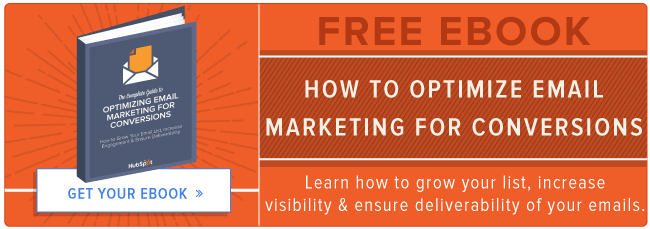Email as a marketing channel isn’t going anywhere anytime soon. According to Nielsen, email is one of the most effective methods for mobilizing contacts. This suggests that if you hope to improve your clickthrough rates or increase your conversion rates, using a personalized email message could be one of the best avenues to explore.
But it's also important to note that email marketing is not a successful marketing strategy on its own. Rather than using it as an isolated tool, your marketing efforts will be far more successful if you properly integrate email marketing into as many inbound campaign channels as you can.
This post will focus specifically on how and why you should focus on integrating email into your inbound campaigns. If you're looking for a more complete guide to email marketing, download The Complete Guide to Optimizing Email Marketing for Conversions. It'll cover everything from building and growing your email list to how to improve your deliverability and segment your marketing emails.
Email & Social Media Integration
Study after study shows that email strategies that integrate social media into their sends lead to better results. In fact, 65% of the top 20% of B2B marketers in social media lead generation integrate email with social media, compared to the industry average of 51% (Aberdeen Research).
Fortunately, integrating social media into your email strategy is easier than you might think. Here are some tactics to help you get started:
Add social sharing buttons to your emails.
Adding social media sharing and follow buttons to your emails will extend the reach of your email sends beyond the recipients in your database, expanding the visibility of your content and your brand -- and increasing the opportunity that you generate some net new leads.
Send emails based on social media insights.
Send targeted emails to subscribers who have mentioned you on social media. Using integrated marketing analytics, you should be able to see a list of email subscribers and leads who have mentioned your company on Twitter. In addition to responding to those highly engaged social leads, you might also send them a follow-up email with targeted information.
Grow your email list through social media.
Leverage your social media presence to give followers a reason to subscribe to your email list and advance their relationship with your brand. For example, consider placing a call-to-action on your Facebook page. Make sure you determine clear benefits to email subscription so that you can turn your social media followers into subscribers.
Email & Blog Integration
If you want people to subscribe to your blog, you need to encourage blog subscriptions! One of the best ways to do this is to clearly emphasize email subscriptions. Remember, there are two ways your visitors can subscribe to your blog -- via RSS and via email. While both are valuable, email subscriptions can often have a much bigger impact than RSS subscriptions. Since subscribers get emailed whenever new content gets published (compared to RSS, which subscribers have to manually check on their own), email has the potential to seriously boost your blog traffic.
Once you successfully attract new subscribers to your blog, emails can also help you maintain those subscriptions and nurture them into leads. Welcome emails are one great way to do that -- they show your new subscribers you appreciate having them as part of your subscriber community. Plus, those people just opted in to get even more email delivered to their already cluttered inboxes. That's a pretty good audience to have.
Building up your blog email subscription is also critical for nurturing. A blog subscriber may not be considered a sales-ready lead quite yet, but the more free blog content they receive, the more likely it is they'll convert into a lead later down the road in one of the posts you send them. The best news? That lead is already educated because of all the great blog content they've been reading, thus more likely to advance through the sales process quickly.
Email & Mobile Integration
Creating a strategy that reflects the changing way recipients open and read email is going to be increasingly important in the coming years. According to Litmus, 48% of all emails are already opened on mobile devices and 69% of mobile users delete emails that aren’t optimized for mobile devices. Remarkably, despite these telling statistics, only 11% of emails are optimized for mobile (Equinox).
So what does it take to make your email strategy mobile?
- Test your email templates to see how they comes across in different mobile devices. You can do that right in HubSpot if we're your ESP, by the way.
- Give your calls-to-action (CTAs) wiggle room -- make sure buttons and links are easy to click for readers using touch screens.
- Offer both plain text and HTML versions of your email.
- Use descriptive alt text under your images in case they don’t display.
- Optimize the landing pages and forms your email links to so mobile users can easily fill out their information.
Email & Analytics Integration
Today’s marketing goes well beyond the boundaries of your website. As a result, individual analytics for your website, social media, email, and other channels just aren’t enough anymore.
A multi-channel view, however, lets you to see how email contacts are navigating their experience with you. Marketing analytics data can answer cross-channel questions, such as:
- How many people clicked through on your email but didn’t convert?
- Are there email contacts that would be better nurtured through social nurturing, as opposed to email nurturing?
- Which email contacts convert into customers at a faster rate -- those who subscribe to the blog first, or those who enter the database through another channel?
Our tool Campaign Assistant uses AI to create targeted content and engage with audiences across multiple channels, saving time and resources. You can then unlock actionable data insights with our analytics tools that provide comprehensive campaign performance reports, enabling you to track important metrics, measure ROI, and utilize data-driven decision-making to optimize your marketing strategies.
Not only do integrated, closed-loop analytics show you the effectiveness of your marketing strategy, but they also provide you the data you need to improve your email targeting. 37% of B2B marketers say lack of user data is the major obstacle to effective segment targeting (B2B Magazine). Despite this desire for user data, 17% of marketers still don't track or analyze email metrics for their organization at all (MEC Labs).
By exchanging single-channel analytics for integrated, closed-loop marketing analytics, you can begin to segment your emails and getting deeper insights into what your contacts actually want from your business.
How else do you use email marketing to improve the performance of other channels?
Email Marketing Campaigns



![Email Marketing Plan: Craft & Track Your Email Campaign [Free Template]](https://53.fs1.hubspotusercontent-na1.net/hubfs/53/Untitled%20design%20-%202025-04-22T133039.283%20(1).jpg)
-1.png)
![30 Brilliant Marketing Email Campaign Examples [+ Template]](https://53.fs1.hubspotusercontent-na1.net/hubfs/53/email-marketing-examples_29.webp)


